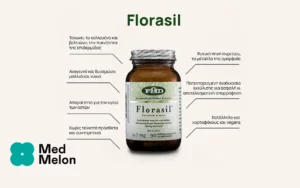Scientific Names of Coconut Oil:
Cocos nucifera L., [Fam. Palmaceae]
Forms:
Coconut oil, cold-pressed.
Traditional Usage:
– AIDS
– Antiseptic
– Antimicrobial
– Antiviral
– Dermatitis
– Dry Hair
– Dry Skin
– Eczema
– HIV Infections
– Itchy Skin
– Moisturizer
– Psoriasis
– Skin Problems
– Sports Nutrition
– Viral Infections
– Weight Loss
– Wrinkles
Overview:
Coconut oil, Cocos nucifera L., [Fam. Palmaceae], is an edible oil that has been consumed in tropical places for thousands of years. Studies done on native diets rich in coconut-based foods show that these populations are generally in good health and don’t have many of the modern diseases of the western world. Coconut oil was once popularly used in western countries like the United States and Canada as well but evidence of the health dangers of saturated animal fats also led to many people abandoning the use of coconut oil. Extra virgin coconut oil, however, is enjoying resurgence in use as newer studies have shown that this largely saturated fat is safe for use as a cooking oil, as opposed to polyunsaturated fatty acids that are more prone to oxidation, and when used as provided by nature without hydrogenation, extra virgin coconut oil does not increase the risk of cardiovascular disease or cause high cholesterol. It is also rich in medium chain triglycerides (MCT) versus long chain triglycerides (LCT) that are useful for exercise performance and weight loss because they are more quickly burned by the body for energy. A recent clinical study with twelve women found that medium chain triglycerides increase the body’s oxidation of long-chain saturated fatty acids and suggests a role for MCT in body weight control over the long term. People in the tropics have also effectively used coconut oil as a traditional moisturizer for centuries. The oil also has skin antiseptic effects. A randomized double-blind controlled clinical trial with 34 patients suffering from dry skin (xerosis) confirmed that coconut oil is as effective and safe as mineral oil when used as a moisturizer (applied to legs twice a day for 2 weeks) and coconut oil has additional antiseptic effects. Coconut oil also has documented strong antiviral activity.
Active Ingredients:
Coconut oil contains: Nutrients per 100 grams of edible portion: Total lipids 100g; Total saturated fatty acids, 86.5g; Total monosaturated fatty acids, 5.8g; Total polyunsaturated fatty acids (18:2) 1.8g; phytosterols, 86 mg; Cholesterol, 0g. Minerals: iron, Fe, 0.04mg; Vitamin E (alpha-tocopherol) 0.09mg; Vitamin E (gamma tocopherol), 0.20; Vitamin K (phylloquinone), 0.5 mcg. [USDA National Nutrient Database for Standard Reference, Release 17 (2004)]. http://www.nal.usda.gov/fnic/foodcomp/cgi-bin/list_nut_edit.pl
Suggested Amount:
Dr. Mary Enig, a fatty acid researcher, suggests a rich lauric acid diet would contain about 24 grams of lauric acid daily for the average adult. This amount could be found in about 3.5 tablespoons of coconut oil or 10 ounces of “Pure Coconut Milk.” Coconut Milk is made in Sri Lanka and imported into the United States. It can be found in health food stores and in local grocery stores in the International Foods section or in specialty grocery stores that sell products imported from Thailand, the Philippines or East India. About 7 ounces of raw coconut daily would contain 24 grams of lauric acid. 24 grams of lauric acid is the therapeutic daily dose for adults suggested by Mary Enig based on her research of the lauric acid content of mother’s milk.
Coconut oil can also be used as a vegetable oil in cooking. For weight loss, in one randomized cross-over trial, subjects were fed weight maintenance diets providing 15%, 45% and 40% of energy as protein, carbohydrate and fat, respectively, with 80% of this fat comprising either a combination of butter and coconut oil (MCT) or beef tallow (LCT). The researchers concluded that the capacity of MCT to increase endogenous oxidation of long-chain saturated fatty acids (LCSFA) suggested a role for MCT in body weight control over the long term. Another study looked at the benefits of enriching a healthy diet with 4% lauric acid from coconut oil or 4% palmitic acid from palm oil and found that lauric and palmitic acid-enriched diets have minimal impact on serum lipid and lipoprotein concentrations and glucose metabolism in healthy young women.
Drug Interactions:
Oils can effectively coat the stomach and prevent the action of poisons; however, they may also therefore reduce the absorption of medications. Thus, oils should be taken separately from other supplements and/or medications.
Contraindications:
Coconut products are contraindicated in persons who have allergies to this nut.
Side Effects:
Coconut oil, taken as a part of a well balanced diet, does not cause any side effects. Because coconut oil contains almost no omega-3 EFAs, it should be taken as part of a balanced diet. Some people may have allergies to coconut products and should therefore avoid all products.
References:
Agero AL, Verallo-Rowell VM. 2004. A randomized double-blind controlled trial comparing extra virgin coconut oil with mineral oil as a moisturizer for mild to moderate xerosis. Dermatitis. 2004 Sep; 15(3): 109-16.
Enig, MG. 1998. Lauric oils as antimicrobial agents: theory of effect, scientific rationale, and dietary applications as adjunct nutritional support for HIV-infected individuals. in Nutrients and Foods in AIDS (RR Watson, ed) CRC Press, Boca Raton, 1998, pp. 81-97.
Kumar PD. 1997. The role of coconut and coconut oil in coronary heart disease in Kerala, south India. Trop Doct. 1997 Oct; 27(4): 215-7.
Papamandjaris AA, White MD, Raeini-Sarjaz M, Jones PJ. 2000. Endogenous fat oxidation during medium chain versus long chain triglyceride feeding in healthy women. Int J Obes Relat Metab Disord. 2000 Sep; 24(9): 1158-66.
St-Onge, Marie-Pierre; Jones, Peter J. H.; Ross, Robert 2002. Medium chain triglyceride consumption for 28 days improves blood lipid profile, increases energy expenditure, and leads to smaller body fat compartments compared to olive oil consumption in overweight men. Circulation 106(19): II. 742.
Schwab US, Niskanen LK, Maliranta HM, Savolainen MJ, Kesa




